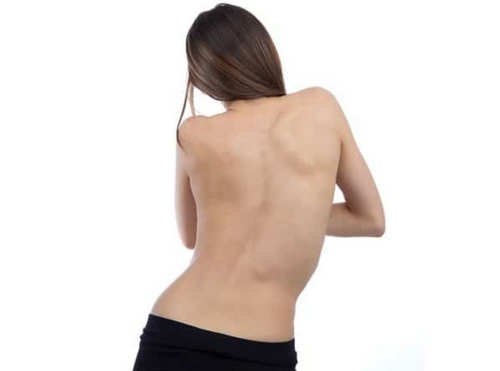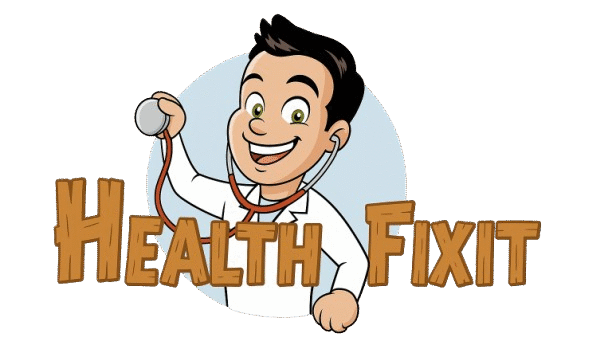What is Levoscoliosis?
Levoscoliosis is a type of scoliosis. A scoliosis is the curvature of the spine.
In the case of levoscoliosis, the curvature of the spine is on the left side of the body. It affects the lumbar portion of the spine that is why it is also called lumbar levoscoliosis. It some instances, levoscoliosis can also affect the thoracic part of the spine.
The condition is called thoracic levoscoliosis. It affects any portion of the thoracic cage from T1 to T12. (1, 2, 3)

Image 1: A comparison between a normal spine and a spine with levoscoliosis.
Picture Source: edc2.healthtap.com

Photo 2: A female with severe levoscoliosis.
Image Source: www.echiropractor.org
Causes of levoscoliosis
The factors that cause scoliosis are the same factors that cause levoscoliosis. Most cases are associated with abnormalities at birth. Other associated causes include the following:
- Neuromuscular problem – The nerves responsible for holding up the spine is uncontrolled.
- Poor posture – It is a predisposing cause and does not have any associated pain. However, when the patient tries to straighten the back, a mild pain is felt.
- Congenital – There is an abnormality of the spine at birth.
- Puberty – Hormonal changes take place during puberty. Hormonal imbalance can possibly lead to overgrowth of the spine and weakening of the muscles.
- Degenerative – As the person gets older, the spine curves leading to scoliosis.
- Idiopathic – There is no underlying cause for levoscoliosis. (2, 4, 5)
Lumbar Levoscoliosis Symptoms
The clinical manifestations are similar to that of the usual scoliosis, but levoscoliosis has more severe symptoms because the curvature of the spine to the left side of the body can create a pressure on the ribcage, which can impair the functions of the heart and lungs.
However, these are only possible for severe cases of levoscoliosis. (3, 6)
The clinical manifestations of lumbar levoscoliosis include the following:
- An obvious curvature of the spine to the left
- The opposite hip bone is elevated
- Difficulty breathing as a result of limited lung expansion in a narrow thoracic cage
- Altered activities of daily living as side effect of left curvature of the spine
- Pain in the back area (7)
- Bending down when walking
- The other leg is shorter than the other
- The shoulders are disproportionate to each other
- Noticeable change in posture
- The body looks like tilting on the other side
- Disproportionate hips
- There is an obvious deformity of the ribcage
- Protruding of the left shoulder blade
- The patient complains of spasm as a result of muscle contraction on the left side of the body
How to diagnose levoscoliosis?
The patient’s medical history and clinical examination should be taken in order to properly diagnose the patient. Additional tests should be performed in order to assess the impact of levoscoliosis and the extent of damage to the spine and the surrounding structures.
To confirm the diagnosis, an x-ray of the spine is done. To check for its impact on the surrounding organs and tissues, an MRI (Magnetic Resonance Imaging) and CT scan are done. These procedures can also detect the presence of tumor in the spine. (8, 9, 10)
Levoscoliosis Treatment
For mild cases of levoscoliosis treatment may not be necessary at all. Mild levoscoliosis usually corrects on its own. However, if the patient is suffering from an obvious levoscoliosis, then a treatment is definitely needed.
There are various ways to treat the condition of the patient and the approach depends on the extent of the condition. The typical treatment choices include the following:
Braces
A levoscoliosis brace is helpful in correcting the posture of the patient. The brace can be hard or soft. Its goal is to not only correct the posture of the patient but also to help in alleviating the pain of the patient. It is helpful in stabilizing the patient’s vertebral column.
A levoscoliosis brace is best applied during the growing years of the patient to make it even more effective in correcting the posture. A SpineCor soft brace is helpful in levoscoliosis treatment adults. It can effectively reduce the pain and stop the progression of the disease. It also works best in children, especially in stabilizing the spinal column.
How does it work? The brace works by stimulating the muscles to move to the opposite side of the levoscoliosis. (2, 6, 8, 9)
FED method
It is a non-invasive treatment approach for levoscoliosis. It involves 3D fixation of the spine with simultaneous extension and derotation. However, for this treatment approach to be effective, the disease should be diagnosed at an early stage. It is even more effective in patients with incomplete bone development.
The FED method is a part of the therapeutic approach for levoscoliosis and it can be done as a part of the outpatient procedure. To speed up the healing process, FED method should be done in conjunction with other levoscoliosis treatment approach. (5, 8, 10)
Physical therapy
It involves exercises that can strengthen the muscles on the side of the body, especially on the weakened parts of the body. There are other levoscoliosis exercises that can help correct and improve the posture.
However, one should keep in mind that the physical therapy alone is not that effective in preventing the progression of levoscoliosis. What it does is it helps maintain the strength of the spine muscles. If the patient has limited movement due to the severity of levoscoliosis or presence of tumor in the spine, the best treatment approach is surgery.
There are various surgical procedures for correcting levoscoliosis and it depends on the surgeon’s discretion as to what surgical approach works best for the patient.
Surgical procedure
Surgery is recommended if all other treatment and management approach fails. Surgery is the last resort and is recommended if the spine angle is more than 45 degrees.
The success of levoscoliosis treatment relies on the early diagnosis. If something is wrong in your spine, you have to consult your doctor right away.
One treatment approach is not that effective in totally reversing the effect of levoscoliosis. It should be a combination of various treatment approach.
References:
- www.healthline.com
- scoliosisbrace.ca
- www.healthandlivingmag.com
- healthsurgical.com
- www.scoliosissos.com
- www.patientslikeme.com
- www.hudsonvalleyscoliosis.com
- www.verywell.com
- www.reference.com ›
- An Osteopathic Approach to Diagnosis and Treatment edited by Eileen L. DiGiovanna, Stanley Schiowitz, Dennis J. Dowling


